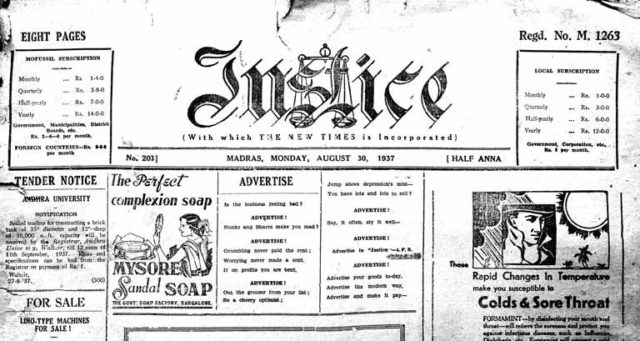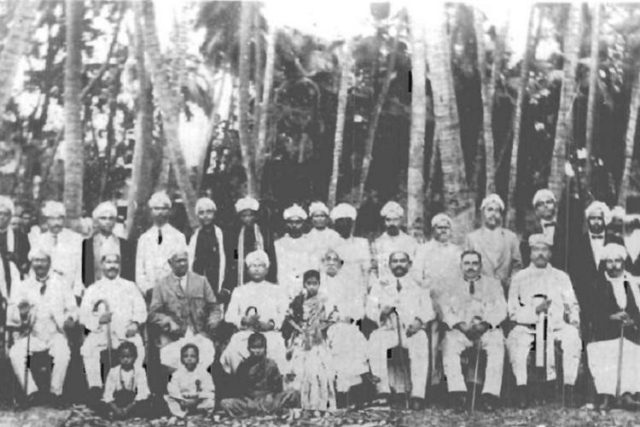PREVIOUS
TM Nair
June 19 , 2019
2383 days
33618
0
- Taravath Madhavan Nair was an Indian medical practitioner, politician and political activist of the Dravidian Movement from the Madras Presidency.

- He founded the Justice Party along with Theagaroya Chetty and C. Natesa Mudaliar.
Early Life
- Nair was born near Tirur on 15 January 1868 in the Taravath family of Palghat, Madras Presidency.
- Nair graduated from Presidency College, Madras and joined the Madras Medical College.
- But prior to completing his course, he moved to Edinburgh of UK.
- His sister Taravath Ammalu Ammal was a Sanskrit and Malayalam scholar who wrote a book in Malayalam on the lives of the 63 Nayanmars
At UK
- He graduated in M.B., Ch.B. at the University of Edinburgh and obtained his M.D. in 1896, with Sanskrit as the compulsory classical subject.
- During his stay in the United Kingdom, he was a member of the Edinburgh Student's Representative Council, Secretary
- Later he became the President of the Edinburgh Indian Association, member of the Edinburgh University Liberal Association and University Union.
- He was also one of the editors of Edinburgh University Liberal's magazine "The Student".
- Prior to his return to India, Nair spent some time in London where he served as Secretary and later Vice-President of London Indian Society which was led by Dadabhai Naoroji.
- He also served as a member of the British Medical Association, the Royal Asiatic Society, the National Liberal Club and the Royal Society.
Activism
- The Antiseptic, a journal for Indian doctors, was founded at Madras in 1904, by Nair, and edited by him up to his death in 1919.
- During World War I, he served as one of the surgeons in the hospital ship, S. S. Madras and was commissioned as a Lieutenant.
- At the end of the war he was awarded the Kaiser-i-Hind medal and posthumously the War Service medal.
- From 26 February 1917 the newspaper Justice began publication, and Dr. Nair was the Chief Editor until his death in 1919.
- In his newspaper, Dr. Nair attacked his opponents in the Indian National Movement and supporters of the Home Rule Movement.
- Nair was a vigorous critic and opponent of Annie Besant, both politically and in regard to her Theosophical activities.
Politics and Admin
- Nair represented Triplicane in the Madras Corporation from 1904 to 1916.
- In 1908, Nair was appointed member of the Labor Commission by the Government of India.
- He submitted a report condemning the situation of workers in factories and recommended the reduction of hours of work.
- He personally submitted his condemnation and recommendations before the Secretary of State for India at London.
- From 1912 to 1916, Dr. Nair was a member of the Madras Legislative Council.
- Nair was associated with the Indian National Congress from the time of his return to India in 1897, but broke from it in 1917.
- He presided over the District Congress at Chittoor, North Arcot in 1907.
- In the Congress sessions in 1898 and 1899, he strongly condemned the present status of Indian officers in the Medical services and campaigned for equal treatment to be meted out to them.
- When Nair lost the elections to the Imperial Legislature of India held in 1916, he blamed caste-based prejudices in the Indian National Congress for his loss.
- Nair felt that the Brahmins were dominating the Indian National Congress.
- He vehemently protested the Home Rule Movement launched by Annie Besant.
Reuniting
- At the time in 1912, there were two groups in the Madras Corporation Council.
- The Non-Brahmin group was led by the legendary Sir Pitti Theagaroya Chetti.
- The other group was led by T.M. Nair.
- The two leaders often clashed at Council meetings even though both were non-Brahmins.
- Natesa Mudaliar realised that if these two leaders could be brought together it would give the Non-Brahmin movement a fast forward push.
- Thus, Natesa Mudaliar was able to reconcile their differences.
Dravidian Movement
- The Madras Non-Brahmin Association was formed in 1909 by two lawyers from Madras city, P. Subramanyam and M. Purushotham Naidu.
- Theagaraya Chetty did not involve himself in the movement until 1912, when the Madras United League was formed.
- It was formed by disaffected non-Brahmin members of the bureaucracy like Saravana Pillai, G. Veerasamy Naidu, Doraiswami Naidu and S. Narayanaswamy Naidu with C. Natesa Mudaliar as its Secretary.
- Later in 1912 itself (October), Madras United league was renamed as Madras Dravidian Association.
- It was the first time the word Dravidian was used for a political entity.
- Panaganti Ramarayaningar, later the Raja of Panagal was elected its President.
- As a part of its programme, the Madras Dravidian Association conducted a hostel called "Dravidian Home"
- It was for the benefit of non-Brahmin students who did not have hostel privileges due to caste-based discrimination.
- In 1914, Natesan ran such a Dravidian hostel in Triplicane, Madras.
- There was a meeting held in Madras in November 1916 by a group of about thirty people, including Theagaraya Chetti and Dr. T. M. Nair.
- They established the South Indian People's Association (SIPA) to publish English, Tamil and Telugu newspapers to publicise grievances of non-Brahmins.
- Theagarya Chetty became the secretary of SIPA.
- The newspaper was named Justice and started publishing from 26 February 1917 onwards.

- T. M. Nair was its first Editor.
- The meeting also formed the "South Indian Liberal Federation" (SILF) as a political association.
- Later, the association came to be popularly called the "Justice Party" due to the publication of the Justice Magazine.

- Theagarya served as the first President of the federation from 1917 till his death in 1925.
- The Justice Party sought a remedy by the earliest adoption of reservation and secularisation by law.
- Along with the Justice Party, EVR Periyar's Self Respect Movement, started in 1925, joined hands to form the Dravida Kazhagam (DK) which served the anti-Brahmin, anti-North Indian and anti-Congress outfits.
- In 1918–19, Dr Nair led a mission to England to speak in support of communal representations before a Joint Parliamentary Committee.
Last Stage
- He died in London on 17 July 1919 as a result of a heart attack.
- His body was cremated at Golders Green, cemetery in London and which still attracts pilgrim.
- In 2008, the Government of India released a postage stamp in his honor.

- Nair Road, an arterial road running through T. Nagar, Chennai is named after him, since he lived and practiced medicine from there.
- He was called as Dravida Lenin by EVR Periyar due to TM Nair’s Social thought and Self Respect philosophies.
- - - - - - - - - - - - - - -
Leave a Reply
Your Comment is awaiting moderation.


